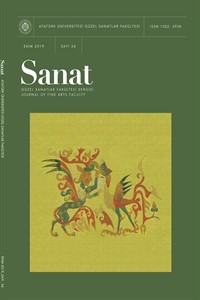Türkiye'deki Gençlerin Video Paylaşım ve Canlı Yayın Platformları Deneyimlerinin Etnografik Araştırma Metotlarından Yararlanarak İncelenmesi
Abstract
YouTube, internette videolar aracılığıyla kullanıcılar arasındaki etkileşimi arttırıp desteklemeyi; beğeni, izlenme sayısı ve yorumlar üzerinden yürüten, 2005’ten bu yana hayatımızda yer bulan son dönemlerin en çok 3. ziyaret edilen çevrimiçi mecrasıdır. Twitch ise çeşitli canlı yayınların bulunduğu ve gençlerin gözünde popülerleşen, ziyaret edilen bir diğer mecradır. Bununla birlikte, video paylaşımı ile canlı-yayın platformları büyük ölçüde çocuklar ve gençler tarafından ziyaret edilmektedirve bu bağlamda gençler arasında iletişim ve kimlik sergileme konusunda yeni bir kültür oluşturmuştur. Bu araştırma,gençlerin beklentilerini ve tecrübelerini temel alıp, bu bireylerin sosyal medyadaki davranışlarının, hareketlerinin, alışkanlıklarının ve sözlü düşüncelerinin analiz edilmesiyle, onlar için kullanıcı deneyimi ve etkileşim tasarımı çerçevesinde, yeni bir sanal mecra tasarlanması konusunda kriterler oluşturması amacıyla gerçekleştirilmiştir. Bu çalışmada, on üç ve on sekiz yaşları arasındaki gençlerle birlikte, gözlemler ve görüşmelerle yapılmıştır. Araştırmaya göre seçilen katılımcı grubundaki gençlerin, sosyal medyayı, çeşitli alanlarda ve ilgi alanlarına göre; öğrenme, deneyim kazanma ve etkileşim kurma gibi sebeplerden dolayı yoğun olarak kullandıkları görülmüştür.Menü elemanları, yerleşimi, renk seçimi ve içerik tercihleri gibi ortaya çıkan bazı ilginç çıktıların kullanılarak, gençler için yeni bir sanal ortam tasarlanmasına ilişkin bir temel oluşturabileceği yönünde çıkarımlar yapılmıştır.
References
- Ashktorab, Z., & Vitak, J. (2016, May). Designing cyberbullying mitigation and prevention solutions through participatory design with teenagers. In Proceedings of the 2016 CHI Conference on Human Factors in Computing Systems (pp. 3895-3905). ACM.
- Baird, D. E., & Fisher, M. (2005). Neomillennial user experience design strategies: Utilizing social networking media to support “always on” learning styles. Journal of educational technology systems, 34(1), 5-32.
- Bassett, R., Beagan, B. L., Ristovski-Slijepcevic, S., & Chapman, G. E. (2008). Tough teens: The methodological challenges of interviewing teenagers as research participants.
- Duggleby, W. (2005). What about focus group interaction data?. Qualitative health research, 15(6), 832-840.
- Dynel, M. (2014). Participation framework underlying YouTube interaction. Journal of Pragmatics, 73, 37-52.
- Ferchaud, A., Grzeslo, J., Orme, S., & LaGroue, J. (2018). Parasocial attributes and YouTube personalities: Exploring content trends across the most subscribed YouTube channels. Computers in Human Behavior, 80, 88-96.
- Fitton, D., Read, J. C. C., & Horton, M. (2013, April). The challenge of working with teens as participants in interaction design. In CHI'13 Extended Abstracts on Human Factors in Computing Systems (pp. 205-210). ACM.
- Fitton, D., & Bell, B. (2014, September). Working with teenagers within HCI research: understanding teen-computer interaction. In Proceedings of the 28th International BCS Human Computer Interaction Conference on HCI 2014-Sand, Sea and Sky-Holiday HCI (pp. 201-206). BCS.
- Gibbs, A. (1997). Focus groups. Social research update, 19(8), 1-8.
- Hamari, J., & Sjöblom, M. (2017). What is eSports and why do people watch it?.
- Harlan, M. A., Bruce, C., & Lupton, M. (2012). Teen content creators: Experiences of using information to learn. Library Trends, 60(3), 569-587.
- Jang, S. H. (2015). “I am a YouTuber”: a netnographic approach to profiling teen use of YouTube (Doctoral dissertation, University of Tasmania).
- Kamal, N. (2013). Designing online social networks to motivate health behaviour change (Doctoral dissertation, University of British Columbia).
- Katterfeldt, E. S., Zeising, A., & Schelhowe, H. (2012, June). Designing digital media for teen-aged apprentices: a participatory approach. In Proceedings of the 11th International Conference on Interaction Design and Children(pp. 196-199). ACM.
- Lange, P. G. (2014). Commenting on YouTube rants: Perceptions of inappropriateness or civic engagement?. Journal of pragmatics, 73, 53-65.
- Lenhart, A., Kahne, J., Middaugh, E., Macgill, A. R., Evans, C., & Vitak, J. (2008). Teens, Video Games, and Civics: Teens' Gaming Experiences Are Diverse and Include Significant Social Interaction and Civic Engagement. Pew internet & American life project.
- Lenhart, A., Purcell, K., Smith, A., & Zickuhr, K. (2010). Social Media & Mobile Internet Use among Teens and Young Adults. Millennials. Pew internet & American life project.
- Madden, M., Lenhart, A., Cortesi, S., Gasser, U., Duggan, M., Smith, A., & Beaton, M. (2013). Teens, social media, and privacy. Pew Research Center, 21, 2-86.
- Odom, W., Zimmerman, J., & Forlizzi, J. (2011, May). Teenagers and their virtual possessions: design opportunities and issues. In Proceedings of the SIGCHI conference on Human Factors in computing systems (pp. 1491-1500). ACM.
- Oygur, I. (2009, August). Designing for Turkish Users: Analyzing the Industrial Designer‐User Relationship in Turkey. In Ethnographic Praxis in Industry Conference Proceedings (Vol. 2009, No. 1, pp. 238-255). Wiley/Blackwell (10.1111).
- Rabiee, F. (2004). Focus-group interview and data analysis. Proceedings of the nutrition society, 63(4), 655-660.
- Race, K. E., Hotch, D. F., & Packer, T. (1994). Rehabilitation program evaluation: use of focus groups to empower clients. Evaluation Review, 18(6), 730-740.
- Rogers, Y., Sharp, H., & Preece, J. (2011). Interaction design: beyond human-computer interaction. John Wiley & Sons.
- Victor, W. (2016). Bridging the Age Gap Between Streaming Platforms: Improving User Experience for In-between Users.
- Yardi, S., & Bruckman, A. (2011, May). Social and technical challenges in parenting teens' social media use. In Proceedings of the SIGCHI Conference on Human Factors in Computing Systems (pp. 3237-3246). ACM.
- Yarosh, S., Bonsignore, E., McRoberts, S., & Peyton, T. (2016, February). YouthTube: Youth video authorship on YouTube and Vine. In Proceedings of the 19th ACM Conference on Computer-Supported Cooperative Work & Social Computing (pp. 1423-1437). ACM.
Details
| Primary Language | Turkish |
|---|---|
| Journal Section | Makaleler |
| Authors | |
| Publication Date | October 17, 2019 |
| Submission Date | July 31, 2019 |
| Published in Issue | Year 2019 Issue: 34 |

